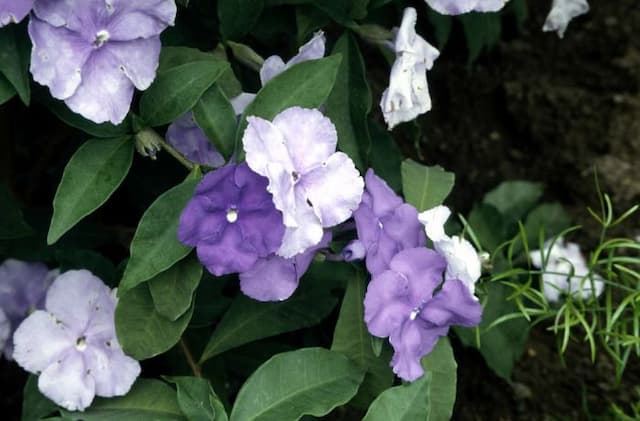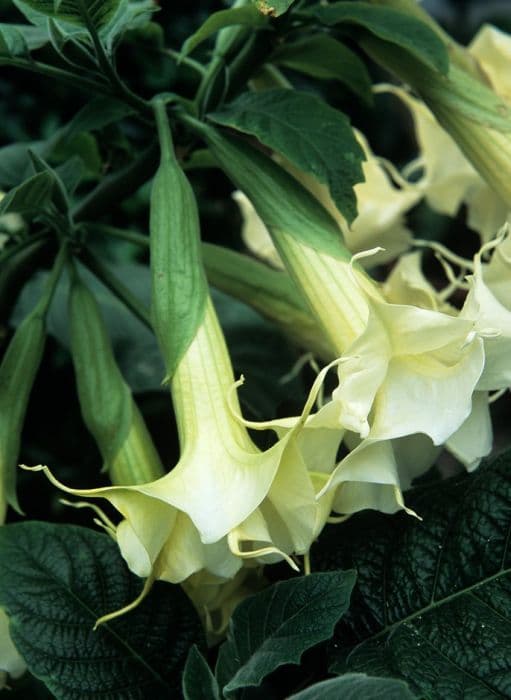Chilean Potato Vine Solanum crispum

ABOUT
The Chilean potato tree is a semi-evergreen perennial vine that is known for its attractive features. It bears a profusion of star-shaped flowers that exhibit an intense blue to violet hue, with a prominent central cone that's typically made up of yellow anthers, creating a compelling contrast against the petals. These flowers grow in loose clusters, and they are followed by small, inedible yellow or red berries that provide additional ornamental interest. The foliage of the Chilean potato tree is also quite appealing. The leaves are dark green, glossy, and have a slightly textured surface, which is where the specific name "crispum" originates. These leaves may have an ovate shape, often with pointed ends, and their edges can be smooth or wavy, contributing to the plant's overall lush appearance. The leaves serve as a lush backdrop for the bright flowers and can remain on the vine throughout the year in milder climates. The stems of the Chilean potato tree are woody and can become quite robust. They often need sturdy support to grow up and over structures such as fences, trellises, or walls, making the plant a common choice for vertical accent in gardens. This climbing habit allows it to spread, providing a dense canopy when trained properly. The vine's intertwining nature and its ability to cover structures quickly make it effective for creating private, green spaces in gardens.
About this plant
 Names
NamesFamily
Solanaceae.
Synonyms
Chilean Nightshade, Chilean Potato Vine, Chilean Potato Bush.
Common names
Solanum crispum var. punctatum, Solanum crispum var. sylvaticum, Solanum leptophyllum, Solanum pseudocrispum, Solanum subinerme.
 Toxicity
ToxicityTo humans
The Chilean potato vine, while not well-documented for severe toxicity in humans, is part of the Solanum family which often contains toxic alkaloids. Members of this family, like the tomato and the potato, have parts that are toxic if ingested in large quantities. Eating parts of the Chilean potato vine could potentially cause symptoms such as nausea, vomiting, diarrhea, and abdominal pain. Ingesting significant amounts of the plant, which is unlikely in a normal garden setting, could lead to more severe symptoms.
To pets
The Chilean potato vine is potentially toxic to pets due to the presence of solanine and other solanum alkaloids, which are a common trait within the Solanaceae family. If a pet ingests parts of this plant, they could exhibit signs of solanine poisoning, which may include gastrointestinal upset, such as vomiting and diarrhea, lethargy, confusion, and in severe cases, neurological signs like tremors or seizures. Prompt veterinary attention is recommended if a pet has ingested any portion of the Chilean potato vine.
 Characteristics
CharacteristicsLife cycle
Perennials
Foliage type
Evergreen
Color of leaves
Green
Flower color
Purple
Height
10 feet (3 meters)
Spread
6 feet (1.8 meters)
Plant type
Climber
Hardiness zones
7
Native area
Chile Peru
Benefits
 General Benefits
General Benefits- Aesthetic value - Solanum crispum, commonly known as Chilean potato vine, is valued for its vivid blue or purple flowers that provide ornamental beauty to gardens and landscapes.
- Habitat for Wildlife - The Chilean potato vine offers shelter and sometimes food to a variety of garden wildlife, including birds and beneficial insects.
- Pollinator attractor - As a flowering plant, it serves as a food source for pollinators like bees and butterflies, helping to support local ecosystems.
- Versatility in Landscaping - It can be used in diverse landscaping designs including as a climber on walls, fences, and trellises.
- Screening - Due to its fast growth and dense foliage, Solanum crispum is often used to provide privacy or as a natural screen.
 Medical Properties
Medical Properties- Antibacterial: Solanum crispum has been studied for its potential antibacterial properties against various strains of bacteria.
- Anti-inflammatory: Components within the plant may have anti-inflammatory effects.
- Antioxidant: The plant may contain antioxidants that help in protecting the body against free radicals.
- Analgesic: There might be pain-relieving compounds present in Solanum crispum.
 Air-purifying Qualities
Air-purifying QualitiesThis plant is not specifically known for air purifying qualities.
 Other Uses
Other Uses- Insect Deterrent: Solanum crispum can be used as a natural insect repellent due to the presence of solanine, a toxic alkaloid that many insects avoid.
- Livestock Feed: While it should be used cautiously due to toxicity, parts of the plant may be used in small quantities as a feed supplement for livestock.
- Hedge and Barrier Plants: With its dense, scrambling habit, Solanum crispum can be grown as an informal hedge or barrier to demarcate boundaries or for privacy.
- Erosion Control: Its robust growing manner can help stabilize soil on slopes and prevent erosion.
- Dye Production: The berries of the plant have been historically used to produce a purple or yellow dye, though this is not a common practice.
- Garden Sculpture: The woody vines can be trained over frames to create living garden sculptures or topiaries.
- Craft Materials: Dried stems and flowers can be used in floral arrangements and craft projects for their unique texture and form.
- Culinary Garnish: While the plant is toxic if ingested, carefully controlled use of flowers can add an ornamental flourish to gourmet dishes.
- Sunscreen for Plants: The dense foliage can provide shade for more delicate plants when grown in a garden setting, acting as a natural form of sun protection.
- Photography Subject: Due to its striking flowers and form, Solanum crispum is a popular subject for botanical and garden photographers.
Interesting Facts
 Feng Shui
Feng ShuiThe Chilian Potato Tree is not used in Feng Shui practice.
 Zodiac Sign Compitability
Zodiac Sign CompitabilityThe Chilian Potato Tree is not used in astrology practice.
 Plant Symbolism
Plant Symbolism- Resilience - Solanum crispum, also known as the Chilean potato vine, is a fast-growing and hardy plant that can thrive in various conditions, symbolizing the ability to withstand adversity.
- Protection - Historically, some Solanum species were thought to possess protective qualities, therefore the Chilean potato vine might symbolize safeguarding one from harm.
- Persistence - With its vigorous growth habit and climbing nature, the Chilean potato vine represents determination and the drive to succeed despite obstacles.
 Water
WaterThe Chilean Potato Tree should be watered regularly, ensuring the soil is kept moist but not waterlogged. During the growing season in spring and summer, watering should be done approximately once a week with about 1-1.5 gallons, depending on the size of the plant and the weather conditions. In the winter months, reduce the watering frequency to every two weeks or when the top inch of the soil feels dry to the touch. It's important not to let the plant sit in water as this could lead to root rot. Always water deeply at the base of the plant to encourage a strong root system.
 Light
LightChilean Potato Trees thrive in full sun to partial shade. They perform best when they receive at least six hours of direct sunlight per day. An ideal spot is one where the plant is exposed to the morning sun with some dappled shade during the hottest part of the afternoon to prevent leaf scorch. The plant can tolerate a position that has light shade, but its flowering may be reduced in lesser light conditions.
 Temperature
TemperatureChilean Potato Trees grow well in temperatures ranging from 50°F to 80°F. They can survive minimum temperatures of around 20°F but should be protected from frosty conditions. The ideal temperature range for promoting growth and flowering is between 60°F and 70°F. Extreme heat above 90°F may stress the plant, so some shade or protection during the hottest part of the day is beneficial.
 Pruning
PruningPruning the Chilean Potato Tree is essential to maintain a desired shape and encourage bushier growth. Prune in late winter or early spring before new growth begins. Remove any dead or damaged branches to improve air circulation and cut back overly long shoots to promote flowering. Pruning up to one-third of the plant's size annually is generally recommended. The best time for pruning is when the risk of frost has passed.
 Cleaning
CleaningAs needed
 Soil
SoilThe Chilean Potato Tree thrives in well-draining soil with a pH of around 6.0 to 7.5. A balanced mix can be created using two parts loam, one part peat or compost, and one part sharp sand or perlite to ensure good drainage and fertility.
 Repotting
RepottingChilean Potato Tree should be repotted every 2 to 3 years or when it outgrows its current pot. Use a container slightly larger than the previous one to allow room for growth.
 Humidity & Misting
Humidity & MistingThe Chilean Potato Tree prefers moderate to high humidity levels but is adaptable to a range of indoor environments. Humidity levels around 40-50% are ideal for this plant.
 Suitable locations
Suitable locationsIndoor
Place Chilean Potato Tree near a sunny window; water regularly.
Outdoor
Plant in sun or partial shade, protect from strong winds, water well.
Hardiness zone
7b-10b USDA
 Life cycle
Life cycleThe life cycle of Solanum crispum, commonly known as Chilean Potato Tree or Chilean Nightshade, begins with seed germination that occurs when conditions are moist and warm. The seedlings then grow into juvenile plants, developing a strong root system and foliage. As the plant matures, it enters the vegetative stage, producing stems and leaves in preparation for flowering. During the flowering stage, Solanum crispum produces clusters of violet-blue flowers, which are sometimes followed by the development of small, non-edible yellow berries during the fruiting stage. After pollination, the seeds are dispersed for the next generation. The plant may go through several flowering and fruiting cycles, depending on environmental conditions, and can live for many years if not subject to hard frost.
 Propogation
PropogationPropogation time
Spring-early summer
Propogation: The Chilean potato tree, scientifically known as Solanum crispum, is commonly propagated through semi-hardwood cuttings. This method, popular for its effectiveness, involves taking a cutting from new growth that has partially matured, usually in late summer to early fall. The cutting, about 4 to 6 inches (10 to 15 centimeters) long, should be made just below a leaf node, from which the lower leaves are removed. The end of the cutting is then dipped in rooting hormone to encourage root development and planted in a well-draining potting mix. The cutting should be kept moist and placed in a warm environment with indirect sunlight until roots have developed, a process that could take several weeks. After rooting, the new Chilean potato tree plant can be gradually hardened off before being transplanted outdoors.









![Calibrachoa [Callie Mango]](/_next/image?url=https%3A%2F%2Fplants-admin.emdemapps.com%2Fimages%2Fplants%2F%2Fimages%2F604b6514b1579.png&w=640&q=75)